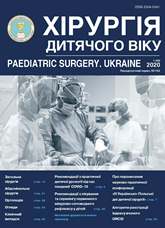Classification and mechanism of forming children’s iliac platypodia
DOI:
https://doi.org/10.15574/PS.2020.66.58Keywords:
flat foot, classification, childrensAbstract
The aim of this work is to create a classification of flatness, which takes into account the accompanying deformations in different parts of the foot; to study the mechanism of formation of flatbed, depending on the etiological causes of pathology.Materials and methods. The analyzed data were obtained during the treatment of the 31 patients aged 4 to 18 years with I-III degrees of PPD which formed according to different etiological types. Clinical methods included determination of the position of the heel bone, pronation of the foot, removal or reduction of the anterior part, deformation of the fingers, state of the iliac arches, overloading, inclination of heel bone and degree of foot mobility (patent for utility model No. 132904 «Method of determining the degree of mobility of the foot», со-authors O.A. Danilov, O.V. Shulga, V.V. Gorelik).
Results. Regardless of the etiology of platypodia appearance, we can separate out combinational variants of foot deformation, the obligatory component of which is the flattening of the iliac arches. Depending on the localization of deformation in one or another foot department, in combination with iliac platypodia, the classification was created that distinguishes 8 types of.
Conclusions. The platypodia progression of different types is affected by the age of the patients, muscles tone, the state of the ligamentous apparatus, changes in the ratio of bones, body w eight and activity of patients. When choosing a method of treatment it is necessary to take into account not only the flattening of the medi al arch, but also the associa ted foot deformation in its various parts in accordance with the above mentioned classification.
The research was carried out in accordance with the principles of the Helsinki Declaration. The study protocol was approved by the Local Ethics Committee of an participating institution. The informed consent of the patient was obtained for conducting the studies.
No conflict of interest was declared by the author.
References
Bezgodkov YuA, Al dveymer IKh, Oslanova AG. (2014). Biomechanical investigations of patients with foot deformities. Modern problems of science and education. 2: 10-12.
Bukina E.N., Goryacheva N.L., Perepelkin A.I. (2015). Issledovanie svodov stopyi u detey doshkolnogo vozrasta. Nauchnoe obozrenie. Pedagogicheskie nauki. 1: 97-98.
Demian YuIu, Huk YuM, Liabakh AP et al. (2017). Flexible flat foot deformity in children with hypermobility of the joints. terminology, clinical and radiological features. Bulletin of orthopedics, traumatology and prosthetics.4: 10-19.
Yefimov AP. (2012). Clinically significant parameters of gait. Traumatology and Orthopedics of Russia. 1: 60-65. https://doi.org/10.21823/2311-2905-2012-0-1-65-75
Kenis VM, Lapkin JuA, Husainov RH et al. (2014). Mobil’noe ploskostopie u detej (obzor literatury). Ortopedija, travmatol. i vosstanovit. hir. detskogo vozrasta. 2: 44-54.
Lazarev IA, Dem`ian YuIu, Huk YuM. (2018). Porivnialnyi analiz biomekhanichnykh parametriv oporospromozhnosti stop pry zastosuvanni ustilok u ditei z hnuchkoiu plosko-valhusnoiu stopoiu. Visnyk ortopedii, travmatolohii ta protezuvannia. 4: 57-65.
Lapkin JuA, Kenis VM. (2011). Varianty staticheskoj ploskoval’gusnoj deformacii stop tjazheloj stepeni u detej. Materialy II Evrazijskogo kongressa i II sezda travmatologov-ortopedov Kyrgyzstana. Medicina Kyrgyzstana. 4: 176.
Ryzhov PV. (2007). Hirurgicheskoe lechenie mielodisplasticheskoj plosko-val’gusnoj deformacii stop u detej: Avtoref. dis. kand. med. nauk. Samara: 22.
Sapogovskij AV, Kenis VM. (2015). Klinicheskaja diagnostika rigidnyh form planoval’gusnyh deformacij stop u detej. Travmatologija i ortopedija Rossii. 4: 46-51.
Arai K, Ringleb SI, Zhao KD, Berglund LJ et al. (2007). The effect of flatfoot deformity and tendon loading on the work of friction measured in the posterior tibial tendon. Clin Biomech (Bristol, Avon). 22(5): 592-598. https://doi.org/10.1016/j.clinbiomech.2007.01.011; PMid:17360087
Basmajian JV. (1981). Biofeedback in rehabilitation: a review of principles and practices. Arch Phys Med Rehabil. 62;10: 469-47.
Carr JB. 2nd, Yang S, Lather LA. (2016). Pediatric pes planus: A state-of-the-art review. Pediatrics.137(3): e20151230. https://doi.org/10.1542/peds.2015-1230; PMid:26908688
Dare DM, Dodwell ER. (2014). Pediatric flatfoot: cause, epidemiology, assessment, and treatment. Curr. Opin. Pediatr.6(1): 93-100. https://doi.org/10.1097/MOP.0000000000000039; PMid:24346183
Downloads
Published
Issue
Section
License
The policy of the Journal “PAEDIATRIC SURGERY. UKRAINE” is compatible with the vast majority of funders' of open access and self-archiving policies. The journal provides immediate open access route being convinced that everyone – not only scientists - can benefit from research results, and publishes articles exclusively under open access distribution, with a Creative Commons Attribution-Noncommercial 4.0 international license(СС BY-NC).
Authors transfer the copyright to the Journal “PAEDIATRIC SURGERY.UKRAINE” when the manuscript is accepted for publication. Authors declare that this manuscript has not been published nor is under simultaneous consideration for publication elsewhere. After publication, the articles become freely available on-line to the public.
Readers have the right to use, distribute, and reproduce articles in any medium, provided the articles and the journal are properly cited.
The use of published materials for commercial purposes is strongly prohibited.

